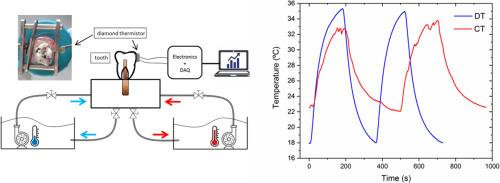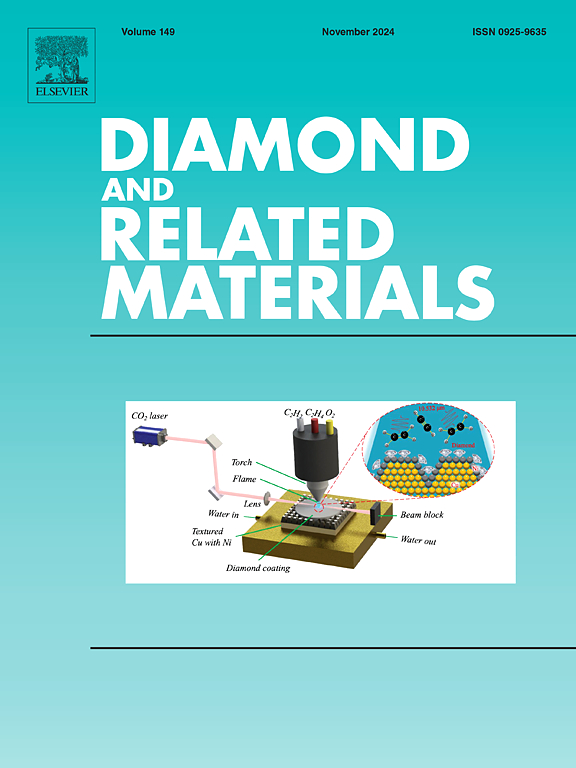Diamond film thermistors for dental vitality assessment
IF 4.3
3区 材料科学
Q2 MATERIALS SCIENCE, COATINGS & FILMS
引用次数: 0
Abstract
In this study, we have demonstrated, for the first time, the use of diamond film thermistors for dental vitality assessment. Thermally sensitive boron-doped diamond films were grown by hot-filament CVD on Si3N4 ceramic substrates, and their thermal sensitivity (β) in the 30–50 °C range was optimized using the Taguchi methodology. This analysis facilitated a comprehensive investigation into the effects of argon flow, gas pressure, CH4/H2 ratio, and the distance between the sample and heated filaments on the films' microstructure, growth-rate (GR), crystalline quality, and β. Additionally, we introduced an empirical parameter (Y), defined as the ratio of β to electrical resistance.
Using optimized CVD parameters, we fabricated a fully functional diamond thermistor with a thermal sensitivity of 1435 K, which was then used in dental vitality assessment tests. These tests were conducted on a specialized stand featuring two closed water circuits, allowing the tooth to be cooled to temperatures as low as 10 °C and heated up to 40 °C. The heating response times of our diamond thermistor (DT) and a standard, metal-oxide-based commercial thermistor (CT) were comparable, but the diamond sensor exhibited a broader temperature detection range. Specifically, the DT was able to detect tooth temperatures within the range of 18 °C to 35 °C, whereas the CT was limited to a narrower range of 22 °C to 32 °C. Additionally, the cooling response time for the DT was significantly shorter (190 s) compared to the 260 s required for the CT. These findings highlight the potential of planar diamond thermistors for applications in endodontic medicine, enabling more accurate assessments of dental vitality.

用于牙科活力评估的金刚石薄膜热敏电阻器
在这项研究中,我们首次证明了金刚石薄膜热敏电阻在牙科活力评估中的应用。通过热丝 CVD 在 Si3N4 陶瓷基底上生长出了热敏掺硼金刚石薄膜,并利用田口方法优化了它们在 30-50 °C 范围内的热灵敏度 (β)。这一分析有助于全面研究氩气流量、气体压力、CH4/H2 比率以及样品与加热丝之间的距离对薄膜的微观结构、生长速度 (GR)、结晶质量和 β 的影响。此外,我们还引入了一个经验参数 (Y),其定义为 β 与电阻的比率。这些测试是在一个专门的支架上进行的,支架上有两个封闭的水回路,可以将牙齿冷却到 10 °C,并加热到 40 °C。我们的金刚石热敏电阻(DT)和基于金属氧化物的标准商用热敏电阻(CT)的加热响应时间相当,但金刚石传感器的温度检测范围更广。具体来说,DT 能够检测到 18 °C 至 35 °C 范围内的牙齿温度,而 CT 则只能检测到 22 °C 至 32 °C 的较窄范围。此外,DT 的冷却响应时间(190 秒)明显短于 CT 的 260 秒。这些研究结果凸显了平面金刚石热敏电阻在牙髓医学中的应用潜力,它能更准确地评估牙齿的活力。
本文章由计算机程序翻译,如有差异,请以英文原文为准。
求助全文
约1分钟内获得全文
求助全文
来源期刊

Diamond and Related Materials
工程技术-材料科学:综合
CiteScore
6.00
自引率
14.60%
发文量
702
审稿时长
2.1 months
期刊介绍:
DRM is a leading international journal that publishes new fundamental and applied research on all forms of diamond, the integration of diamond with other advanced materials and development of technologies exploiting diamond. The synthesis, characterization and processing of single crystal diamond, polycrystalline films, nanodiamond powders and heterostructures with other advanced materials are encouraged topics for technical and review articles. In addition to diamond, the journal publishes manuscripts on the synthesis, characterization and application of other related materials including diamond-like carbons, carbon nanotubes, graphene, and boron and carbon nitrides. Articles are sought on the chemical functionalization of diamond and related materials as well as their use in electrochemistry, energy storage and conversion, chemical and biological sensing, imaging, thermal management, photonic and quantum applications, electron emission and electronic devices.
The International Conference on Diamond and Carbon Materials has evolved into the largest and most well attended forum in the field of diamond, providing a forum to showcase the latest results in the science and technology of diamond and other carbon materials such as carbon nanotubes, graphene, and diamond-like carbon. Run annually in association with Diamond and Related Materials the conference provides junior and established researchers the opportunity to exchange the latest results ranging from fundamental physical and chemical concepts to applied research focusing on the next generation carbon-based devices.
 求助内容:
求助内容: 应助结果提醒方式:
应助结果提醒方式:


